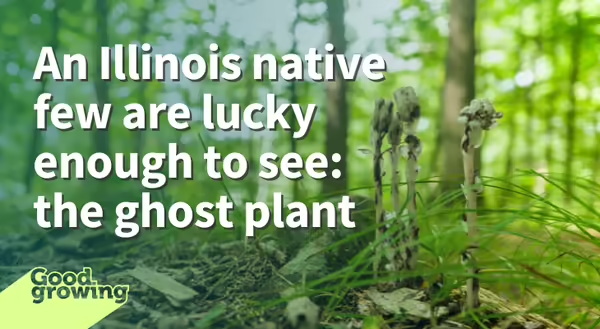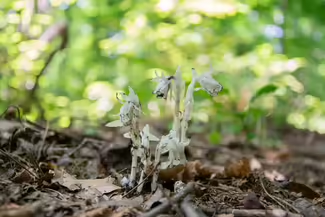
The recent turn in the weather has me feeling all the fall vibes. I’m ready for leaves to turn, for pumpkin spice to be in everything, and for sweater weather. Although as a kid and young adult, Halloween hasn’t traditionally been my favorite holiday, my kids love it which means I love it. As our household prepares for the tricks and the treats, there is no way I’m going to let an opportunity go by to talk about ghost plants!
Ghost Plant
Known by the common names of ghost plant or Indian pipe, Monotropa uniflora is an Illinois native perennial. The native distribution of the species is vast, it is found throughout the entire United States except for the southwestern states, Colorado, and South Dakota.
The ghost plant is a member of a small group of plants that have foregone the need to do photosynthesis and therefore lack chlorophyll in its tissue. Without chlorophyll, the entire plant is translucent and appears white or pale pinkish in color with black spots. The plant utilizes the nutrients produced by woodland trees by parasitizing a fungus that facilitates nutrient sharing from the tree to the ghost plant.
Ghost plants spend most of their life underground gathering nutrients. It emerges once enough energy has been collected to flower and disperse seed. Ghost plants emerge as a cluster of unbranched stems that can be mistaken for a single plant.
The leaves are alternately arranged on the stem and are scale-like. Each stem terminates in a single flower, hence the epithet uniflora, that droops downward until pollinated. Once pollinated, flowers become erect as the seeds mature. Once ripe, seed capsules split open allowing the small seeds to be dispersed by the wind. The plant is said to persist after seeds have been dispersed.
Why can’t I find this cool plant?
Despite its wide geographic distribution Indian pipe is difficult to observe in the wild. There are a few conditions that contribute to the elusive nature of the ghost plant.
For starters, ghost plants can be challenging to locate due to their petite size. Ranging in height between four and ten inches means finding such a small plant in a woodland can feel like looking for the proverbial needle in a haystack.
Knowing this, you may be asking yourself why not just cultivate the plant so you don’t have to look for it? To that, I say, great question. However, due to the lack of chlorophyll, the plant has developed a relationship with the root systems of woodland trees. Facilitated by specific fungi in the genera Russula and Lactarius, the ghost plant is able to exist because it access the carbohydrate and nutrient resources of adjacent trees. Recreating the specialized conditions necessary for this relationship to thrive has proven extremely difficult.
Finally, since ghost plants must be viewed in the wild, it would make sense to go looking for them during their bloom time. The challenge with this methodology is that the bloom period is variable, ranging from late spring to autumn.
More unusual facts about a highly unusual plant
- The lack of pigmentation causes some mistaken identification as a fungus although the species is a saprophytic flowering plant.
- The ghost plant is a member of the Ericaceae family, a family that also includes blueberries, cranberries, azaleas, and rhododendrons.
- Other common names for the plant include corpse plant and death plant.
- Seeds have nearly no food storage making germination challenging. Instead, seeds chemically mimic the root system of woodland trees to attract mycorrhizal fungi. Seeds attach to the fungus and begin collecting nutrients through the fungi.
Good Growing Fact of the Week: It is said that the Ghost Plant was one of American poet Emily Dickinson’s favorite flowers. She described the plant as being “the preferred flower for life” in a message to a friend.
Thank you for reading!
Sign up for our emails! Want to get notified when new Good Growing posts are available? SIGN ME UP
Give us feedback! How helpful was this information (click one): Very helpful | Somewhat helpful | Not very helpful

